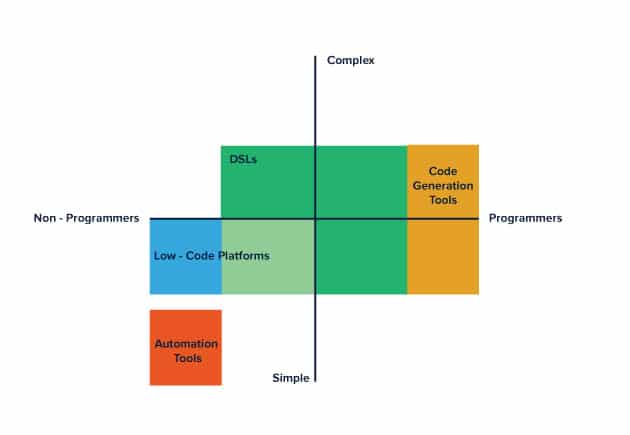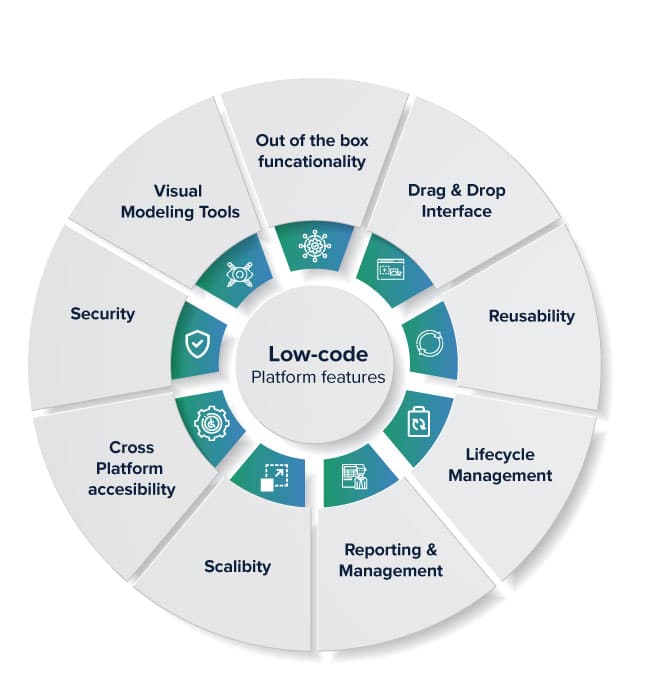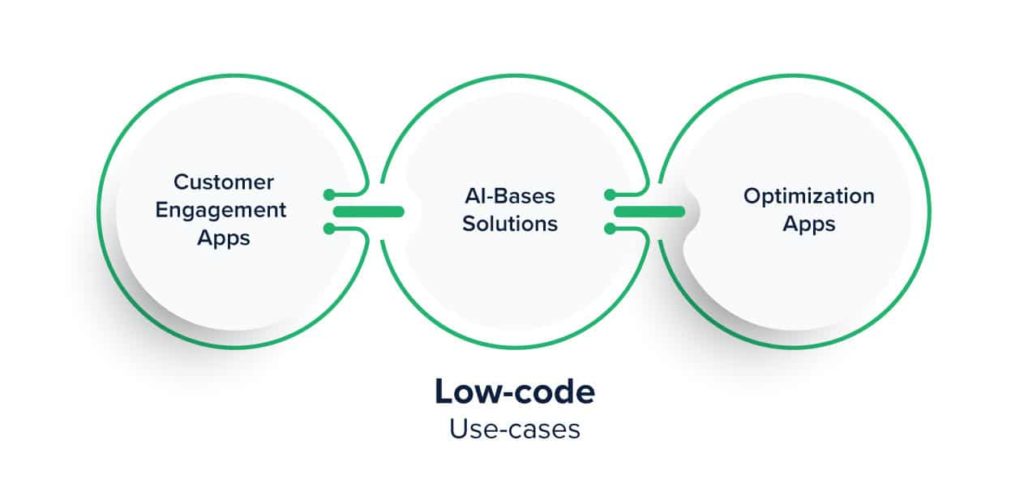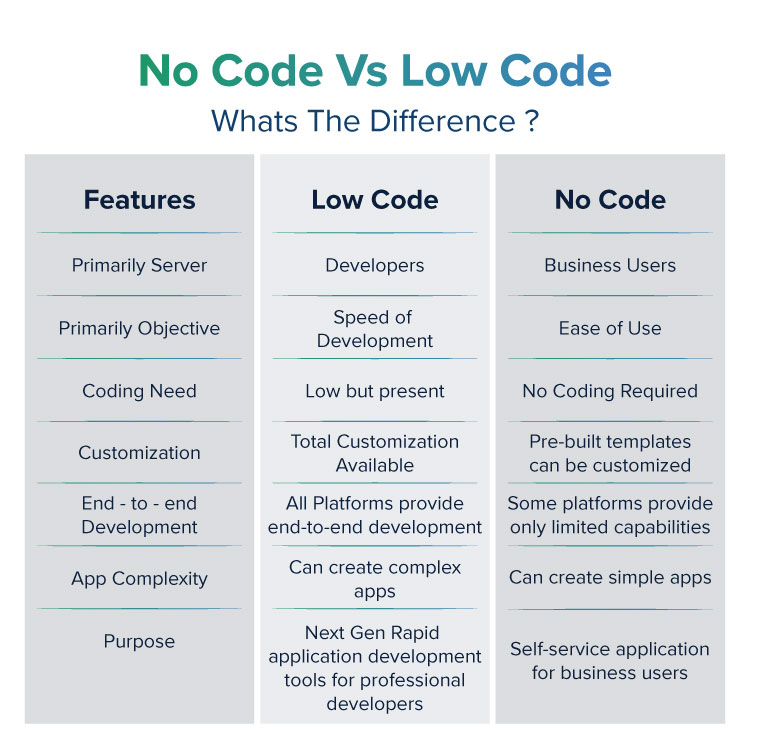In a dynamic business ecosystem where agility is tantamount to success, every organization is driven by the objective to gain a competitive edge in the market. This means staying on top of the latest technological developments and creating innovative and futuristic workflow processes, services, and products. All of this, in turn, translates into a mounting demand for developers. The US Bureau of Labor Statistics indicates a growth of 24% in the demand for software developers between 2016 to 2026.
There just may not be enough skilled professionals out there for every organization to supplement its digital transformation needs with the right talent. So then, how do you stay on track to meeting your objective of making processes and products more agile? That’s where low code platforms come into the picture.
These platforms are revolutionizing the software development process. In comparison to the traditional development methods, low code platforms allow businesses to optimally reap the benefits of their data, thus facilitating the creation of software with less effort, time, and cost. Low-code platforms can encompass all development-related tasks and are increasingly being used to create business processes and workflows, in addition to software products and their supplementary elements.
The versatility of these platforms also shines through in their ability to cater to the needs of businesses of different structures and sizes across industry verticals. Thus making digital transformation more accessible and affordable for everyone.
So, what is a low code platform and how can your business benefit from it? Let’s delve deeper to find out:
What is Low Code?
Low-code is an approach to software development where building applications and related processes entail little to no coding. A platform for low-code development relies on drag-and-drop functionalities, along with simple logic-driven visual interfaces, in place of extensive coding involved in traditional development practices. Thanks to the intuitive tools that these platforms are equipped with, even users with no formal training in software development or coding know-how can create software applications, be it business apps or mobile apps.

Owing to the ease of use and simpler functionalities, the low code approach is fast becoming the preferred alternative to traditional methods of software development. The platforms can be used just as easily by non-professional developers as by their professional counterparts to create software applications of varying degrees of complexity.
All of this boils down to an augmented ability to automate processes, quickly meet changing demands and accelerate digital transformation – perfectly aligning with the quest of agility.
Low Code Platform Features
So, low code platforms are designed to make the software development process more agile, user-friendly, and scalable. But what makes them capable of simplifying what is traditionally a complex process to such an extent?

Here is a rundown on the key low code platform features that serve as the backbone of this approach to software development:
- Visual modeling tools
The low code platform is powered by built-in components that are capable of presenting any information in a format that is comprehensible to anyone, irrespective of the level of their technical training or know-how. These visual modeling tools and methods play a crucial role not just in equipping anyone with developer abilities but also in speeding up the process of creating software applications in comparison to code-based development.
- Out-of-the-box functionality
All leading low code platforms come equipped with an out-of-the-box (OOTB) functionality that renders redundant the need to build application core modules from scratch. The platforms already have a series of modules needed for application development, ranging from data management to sales processes management or service management needed in customer-facing apps.
- Drag-and-drop interfaces
Another stand-out feature of low code platforms is their drag-and-drop functionality that serves as one of the central elements of simplifying the development process. These interfaces allow you to drag and drop different components of an application rather than having to build all on your own. The benefits of drag-and-drop functionality are not only leveraged by amateur developers but the feature is also equally useful for professional developers.
- Reusability
The out-of-the-box feature of low code development platforms also brings in the element of reusability, allowing repeated use of pre-configured modules, components, and functionalities for different applications. The pre-configured modules, for instance, comprise certain core functions that are common for several applications. These can simply be used wherever applicable, making the process of application development a lot quicker. Reusability is one of the central tenets of this approach to development, and without it, the essence of low code would be lost.
- Security
Without adequate security features, no low code tool can be considered a sufficient solution for software development, irrespective of how user-friendly or functional it may be. Having adequate security protocols in place ensures that the apps being built using the low code platform are safe and protected at all times. At the same time, security features are crucial to the security of the platform as a whole as well.
- Cross-platform accessibility
A robust low code platform is also equipped with multi-device compatibility. This feature supports the ability to use the low code development platform on any device that runs on one of the major operating systems. At the same time, it helps in building apps that are compatible across a spectrum of core platforms and devices.
- Scalability
Scalability is also one of the non-negotiable features of low code systems. This feature ensures that the apps built using the low code approach can easily adapt to the growing or changing business needs, catering just as seamlessly to twenty users or two hundred.
- Reporting and Monitoring
The reporting and monitoring feature of low code platforms helps you monitor processes and workflows of apps, and in turn, track their effectiveness at every step of the way. This is essential for assessing application performance as well as for analytics. Low code systems also have scope for comparative monitoring that enables you to track the performance of other apps vis-à-vis yours.
- Lifecycle Management
The effective lifecycle management of applications in low code tools streamlines and simplifies the different stages of the development process, right from testing to debugging and deployment. This feature allows users to access all the information pertaining to an application as well as its development process, and revert to an older version if necessary for better functioning and lifecycle management.
What can Low Code Platforms be Used for?
While software development is one of the primary and most sought-after uses of low code platforms, in their present form, low code tools are capable of doing a lot more. These platforms can be leveraged to create an ecosystem that enables businesses and organizations to seamlessly use the apps built with this approach.

Here are some of the key uses of low code platforms that facilitate the effective resolution of a host of business processes and tasks:
- Customer engagement apps
Using low code solutions, you can build enterprise-grade applications to handle different business tasks. The apps can be used to handle complex business processes or address customer needs and even drive customer engagement through a more personalized user experience.
- AI-based solutions
Low code platforms can also be used to build applications based on machine learning and AI algorithms. This accelerates efficiency by facilitating more effective processing of data speedily as compared to manual operations.
- Defining build processes
Low code solutions can also be an effective tool for handling tasks of varying complexities by defining build processes and workflows and thus driving in automation.
- Optimization apps
A low code platform makes for a reliable choice for anyone looking to enhance the efficiency of operations by building applications that are capable of automating processes. As a result, these applications are optimized and capable of reducing cost while also cutting back the risk of error with the help of automation.
Low Code Vs No Code
Low code platforms come with a definitive edge over the more traditional approaches toward software development and are proven to be better aligned with the dynamic requirements of today’s business world. When we discuss the low code approach to development, a mention of no-code is bound to spring up. So what is the low-code vs no-code debate all about? In the present and futuristic context of application development, is one better than the other?

To understand that, one first needs to establish whether the two are really as different as they’re made out to be or more of the same. There are diverging schools of thought on this. While some believe no-code to be a more advanced choice to low-code, others think that the similarities between the two far outdo the differences. In some cases, no-code is also touted as just a marketing spin on the low-code phenomenon.
The answer to which of these opinions hold water or whether they’re all valid in their own right lies in the history and origin of these development paradigms. The ‘high-level programming abstractions’, which refers to the development platforms’ ability to hide complexities and present only the bare essentials to the user, that have been all the rage since the 90s are the basic premise on which low code platforms operate.
In low code as well as no code development, these abstractions are enhanced at three key levels – capability or internal, behavioral or logical, and use or external. How these abstractions translate into the platforms’ ability to build, test, deploy and manage applications is where the difference lies.
For instance, if you trigger a workflow with predefined conditions, low code, as well as no-code platforms where this set of actions has already been configured into code blocks, makes it easy to read and interpret them. In case new conditions unique to your business requirements evolve along the way, a no-code platform would be ill-equipped to handle them.
On the other hand, low code development platforms would instantly offer the means to quickly customize the code blocks to accommodate these new conditions, in addition to the predefined ones.
While both these solutions are designed to boost agility, the scope of their capabilities is what sets them apart. Keeping in mind your long-term digitization goals is the best way to choose between the two.
Benefits of Low Code
The innovative and path-breaking way of software development has the potential to revolutionize any organization’s tech capabilities. That too without incurring heavy costs. Some of the most tangible benefits of working with low code solutions to meet your tech requirements include:
- Unparalleled time-to-value
With low code platforms, you can leverage the existing talent in your workforce to build and deliver apps rapidly. The low-code attributes such as reusable components, visual user interface, and development toolkit help in enhancing developer productivity improve developer productivity exceptionally. The built-in tools promote cross-collaboration between different teams, resulting in faster decision-making. All of these factors combined translate into an unparalleled time-to-value in your application development process.
- Build more at scale
This approach to software development also paves the way for building maintainable solutions that can be easily scaled using cloud-native architecture. With low code solutions, you can undertake extensive projects to roll out solutions such as modernizing critical systems and automation apps without coughing up a huge capital or them eating into your bottom line. Not just that, these platforms also equip you with the ability to deliver continuous upgrades to your applications and related services, thereby improving the end-user engagement with immersive and conversational experiences.
- A new way of developing
If agility is what you seek to be able to quickly respond to the ever-evolving customer and business needs, a low code platform is just the solution you need to work with. It helps you shape a new way of software development by breaking down silos and working toward fostering strong business-IT collaborations. With low code as a platform for software application development, you can cultivate a new, more empowered team of developers across the organizational structure who can contribute toward your objective of staying nimble and quickly keep up with the times.
The Bottom Line
Smart low code platforms can overhaul development lifecycles, making them more seamless. The entire premise of this approach to app development is to make the process quicker and simplified by enabling developers to iterate and prototype with ease. These benefits extend not just to professional developers but also users without any formal training or expertise in the IT sector. In other words, low code opens up the world of software development to the legions of intrigued, innovative minds. Anyone willing to try can build robust applications using this approach. With more and more businesses needing an extensive IT infrastructure and support to keep up with the times, this ability makes low code platforms the future of development.
